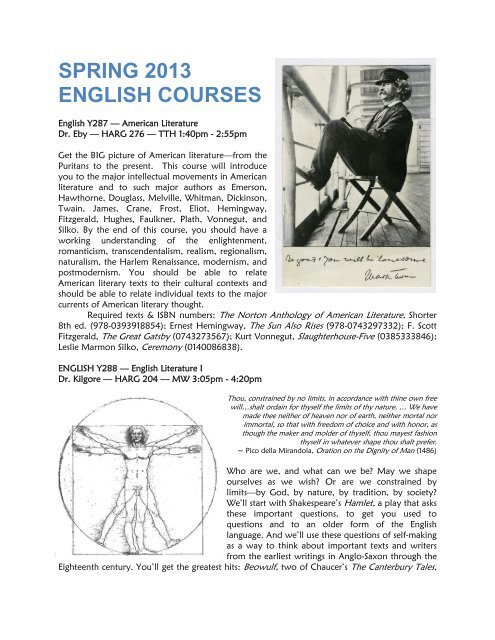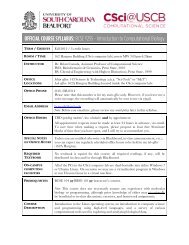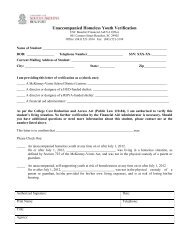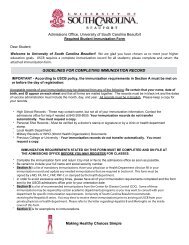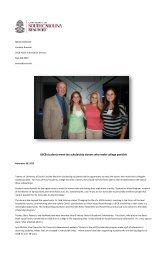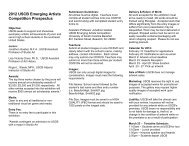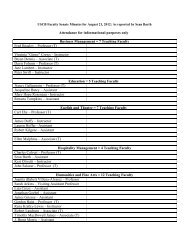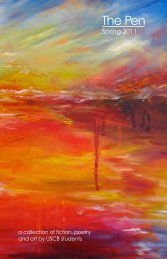SPRING 2013 ENGLISH COURSES
SPRING 2013 ENGLISH COURSES
SPRING 2013 ENGLISH COURSES
Create successful ePaper yourself
Turn your PDF publications into a flip-book with our unique Google optimized e-Paper software.
<strong>SPRING</strong> <strong>2013</strong><br />
<strong>ENGLISH</strong> <strong>COURSES</strong><br />
English Y287 — American Literature<br />
Dr. Eby — HARG 276 — TTH 1:40pm - 2:55pm<br />
Get the BIG picture of American literature—from the<br />
Puritans to the present. This course will introduce<br />
you to the major intellectual movements in American<br />
literature and to such major authors as Emerson,<br />
Hawthorne, Douglass, Melville, Whitman, Dickinson,<br />
Twain, James, Crane, Frost, Eliot, Hemingway,<br />
Fitzgerald, Hughes, Faulkner, Plath, Vonnegut, and<br />
Silko. By the end of this course, you should have a<br />
working understanding of the enlightenment,<br />
romanticism, transcendentalism, realism, regionalism,<br />
naturalism, the Harlem Renaissance, modernism, and<br />
postmodernism. You should be able to relate<br />
American literary texts to their cultural contexts and<br />
should be able to relate individual texts to the major<br />
currents of American literary thought.<br />
Required texts & ISBN numbers: The Norton Anthology of American Literature, Shorter<br />
8th ed. (978-0393918854); Ernest Hemingway, The Sun Also Rises (978-0743297332); F. Scott<br />
Fitzgerald, The Great Gatsby (0743273567); Kurt Vonnegut, Slaughterhouse-Five (0385333846);<br />
Leslie Marmon Silko, Ceremony (0140086838).<br />
<strong>ENGLISH</strong> Y288 — English Literature I<br />
Dr. Kilgore — HARG 204 — MW 3:05pm - 4:20pm<br />
Thou, constrained by no limits, in accordance with thine own free<br />
will…shalt ordain for thyself the limits of thy nature. … We have<br />
made thee neither of heaven nor of earth, neither mortal nor<br />
immortal, so that with freedom of choice and with honor, as<br />
though the maker and molder of thyself, thou mayest fashion<br />
thyself in whatever shape thou shalt prefer.<br />
~ Pico della Mirandola, Oration on the Dignity of Man (1486)<br />
Who are we, and what can we be? May we shape<br />
ourselves as we wish? Or are we constrained by<br />
limits—by God, by nature, by tradition, by society?<br />
We’ll start with Shakespeare’s Hamlet, a play that asks<br />
these important questions, to get you used to<br />
questions and to an older form of the English<br />
language. And we’ll use these questions of self-making<br />
as a way to think about important texts and writers<br />
from the earliest writings in Anglo-Saxon through the<br />
Eighteenth century. You’ll get the greatest hits: Beowulf, two of Chaucer’s The Canterbury Tales,
More’s Utopia, Renaissance lyrics and sonnets, the metaphysical poems of Donne and Herbert,<br />
Swift’s modest proposal, Gray’s elegy, and the literally heart-wrenching new-world novella by<br />
Aphra Behn, Oroonoko.<br />
By the end of the course, successful students should understand what British literature<br />
before 1800 is like — its concerns, its genres and forms, its verbal styles, and its development<br />
throughout the period (related to this is a general understanding of how this literature differs<br />
from more modern literature). More specifically, students should develop an effective practice<br />
of literary note-taking (in textbooks, in class, and out of class), be familiar with assigned texts,<br />
and have the ability to recall key details about these texts (such as their authors, time period,<br />
genres, characters, plots, themes, etc.), have a basic competence at close reading literary texts<br />
from the period covered (that is, performing sustained and careful analysis of texts, using<br />
basic elements of literary analysis–theme, imagery, verbal style, form and genre, etc.), develop<br />
skills of comparing and contrasting different texts and concepts, develop the ability to create their<br />
own interpretations and understandings of texts and concepts, based on careful analysis,<br />
demonstrate competence of the above through class discussion, writing essays, and effective<br />
responses to a comprehensive exam, have a basic competence at finding and reading<br />
professional literary criticism, and to be able to effectively use criticism to frame and create one’s<br />
own argument, and never, ever refer to Shakespearean language as Old English again. Remaking<br />
yourself as Chaucer’s Wife of Bath is purely optional.<br />
Required Texts: The Norton Anthology of English Literature, edited by Stephen<br />
Greenblatt, 9th ed. Volumes A, B, and C. (9780393928334); Hamlet by William Shakespeare,<br />
edited by Robert S. Miola (Norton Critical ed. 978039392958-4). The USCB Bookstore may<br />
have a package deal. Online texts are inadequate substitutes for the required texts. For more<br />
details, email me at kilgorer@uscb.edu.<br />
BENG Y289 — <strong>ENGLISH</strong> LITERATURE II<br />
Exploring Literary Tradition: English Literature from 1800<br />
to the Present<br />
Dr. Hoffer — HARG 276 — MW 1:40pm - 2:55pm<br />
Convention...Legacy...Tradition. Each of these words<br />
addresses the relationship between past and present, and<br />
each suggests a sense of cohesion, a commonality of<br />
patterns, concerns, and styles. All literature is, in a sense,<br />
part of a larger tradition that is built upon, influenced by,<br />
and often reactionary to the texts that preceded it.<br />
Today’s best-selling authors and literary prize winners<br />
(even TV and film writers!) are all a part of the literary<br />
tradition. Exploring it can thus allow us a fuller, deeper<br />
understanding of the stories we tell—and how we tell<br />
them. English 289 is designed to offer you a survey (a<br />
broad overview) of major writers and works in the English<br />
literary tradition from 1800 to the present. Along the way, we will learn about major literary<br />
and cultural movements as we discover the Romantic, Victorian, Modern, and Contemporary<br />
periods. In addition to gaining experience recognizing the formal techniques and devices of<br />
poetry, drama, and prose fiction, we will contextualize the literature we read by discussing the<br />
philosophical and artistic movements, revolutions and wars, scientific and technological<br />
advancements, and social issues such as race, class, and gender that have informed literature in<br />
prior centuries as in our own. Students will improve their ability to read, interpret, discuss, and<br />
2
write about important texts in the English Literature tradition and will demonstrate their<br />
comprehension of the material through two exams (mid-term and final) and two essay<br />
assignments. The books required for this course are: The Broadview Anthology of British<br />
Literature, Vol. B (ISBN 9781551118697), the Penguin Dictionary of Literary Terms & Literary<br />
Theory (ISBN 9780140513639), as well as Jane Austen’s Persuasion (Broadview edition: ISBN<br />
9781551111315).<br />
BENG Y402 001—Tudor Literature<br />
Dr. Kilgore—HARG 204—TTH 12:15pm-1:30pm<br />
Writing the Queen<br />
In 1588, Queen Elizabeth, leading her troops into battle<br />
against the Spaniards, conceded she had “the body but of<br />
a weak and feeble woman,” but insisted she had “the<br />
heart and stomach of a king, and a king of England too.”<br />
If the Renaissance is an international movement of arts<br />
and letters, then the flowering of arts of letters in England<br />
under Elizabeth is a nationalistic enterprise. It also is<br />
gendered. The virgin queen, Elizabeth, is the author,<br />
subject, or object of much of the writing we’ll read,<br />
leading to the bizarre circumstance that poems about<br />
shepherds singing to shepherdesses are very often poems<br />
about domestic and foreign policy. But they’re also really<br />
good poems.<br />
In this course, you’ll become familiar with the<br />
major non-dramatic genres and modes of Renaissance<br />
literature: treatise, lyric, pastoral, romance, and epic.<br />
You’ll sample from a variety of important sixteenthcentury<br />
prose writings (including Machiavelli, Castiglione,<br />
and Tyndale), and then focus on the poetry of Christopher Marlowe, Edmund Spenser, Philip<br />
and Mary Sidney, and Aemilia Lanyer — all of which have Queen Elizabeth inspiring and<br />
haunting their pages. We’ll also read the poetry of Elizabeth herself and the love letters her dad<br />
(Henry VIII) wrote to her mom (Anne Boleyn). Longer readings include Book One of Spenser’s<br />
The Faerie Queene, Philip Sidney’s Astrophil and Stella, Marlowe’s translation of Ovid’s Elegies,<br />
Lanyer’s Salve Deus Rex Judaeorum (don’t worry, it’s in English), but even these longer readings<br />
are relatively short: we’ll need to read them carefully.<br />
Attendance mandatory, discussion encouraged, presentations given, frequent writing<br />
designed to lead to a researched argumentative essay of 9-10 pages, final exam, sense of humor,<br />
and spirit of inquiry essential.<br />
Required texts with ISBNs: Sir Philip Sidney: The Major Works (Oxford UP, 2002,<br />
9780199538416); Christopher Marlowe, The Complete Poems and Translations (Penguin, 2007,<br />
9780143104957); Edmund Spenser’s Poetry (Norton, 1992, 9780393962994); Renaissance<br />
Women Poets (Penguin, 2001, 9780140424096); Elizabeth I and Her Age, edited by Felch and<br />
Stump (Norton, 2008, 9780393928228). Online texts are inadequate substitutes for the required<br />
texts. For more details, email me at kilgorer@uscb.edu.<br />
3
English Y422 001 — American Literature, 1860-1910<br />
Dr. Eby — HARG 276 — TTH 10:50am-12:05pm<br />
American Realism, Regionalism, and Naturalism<br />
Explore American literature during the Gilded Age—the age<br />
dominated by literary realism, regionalism, and naturalism. In<br />
addition to a few shorter works by writers such as Stephen<br />
Crane, Jack London, and Charles Chesnutt, we’ll read Mark<br />
Twain’s A Connecticut Yankee in King Arthur’s Court, Henry<br />
James’s A Portrait of a Lady, William Dean Howells’s The Rise<br />
of Silas Lapham, Edith Wharton’s The House of Mirth, and<br />
Theodore Dreiser’s Sister Carrie. We’ll try to place these texts<br />
against a historical background of explosive industrial growth,<br />
the emergence of vast wealth and terrible poverty, the<br />
urbanization of America, rampant political and corporate<br />
corruption, the failure of Reconstruction in the South, the<br />
closing of the frontier, and the emergence of the U.S. as a<br />
global (some would say, imperial) power. We will also<br />
explore the intellectual influence on American literature of<br />
Charles Darwin, Herbert Spencer, Karl Marx, Friedrich<br />
Nietzsche, and William James.<br />
Required texts with ISBN numbers: Mark Twain, A<br />
Connecticut Yankee in King Arthur’s Court (978-<br />
0520268166); Henry James, A Portrait of a Lady (978-0393966466); William Dean Howells,<br />
The Rise of Silas Lapham (978-0140390308); Edith Wharton The House of Mirth (0451527569);<br />
and Theodore Dreiser, Sister Carrie (978-0140188288). Please be especially careful to get the<br />
correct editions of A Connecticut Yankee and A Portrait of a Lady!<br />
BENG Y427 001—Southern Literature<br />
Dr. Malphrus—HARG 204—MW 12:15pm-1:30pm<br />
“Whenever I’m asked why Southern writers particularly have a<br />
penchant for writing about freaks, I say it is because we are still able<br />
to recognize one.”<br />
~ Flannery O’Connor<br />
Who are the writers that have shaped Southern Literature?<br />
When did Southern Literature emerge? Where does the South<br />
begin and end – is it all about the Mason-Dixon Line? How<br />
can we tell if a particular text is Southern or not? Why do<br />
readers, writers, scholars, and the general public around the<br />
world continue to be fascinated by all things Southern? . . .<br />
These are some of the initial questions we’ll address in this<br />
senior level seminar on Southern Literature. In addition to top<br />
guns such as Mark Twain, William Faulkner, Eudora Welty, Richard Wright, Robert Penn Warren,<br />
Flannery O’Connor, Tennessee Williams, and the like, we will focus our attention specifically on<br />
South Carolina writers – from William Gilmore Simms to Henry Timrod to Mary Boykin Chesnut<br />
to Julia Peterkin to DuBose Heyward to James Dickey to Percival Everett to Josephine<br />
Humphreys to Dorothy Allison to Nikky Finney to Pat Conroy to Ron Rash – for starters.<br />
4
Literary roots run deep in the Palmetto state, and we’ll spend the semester digging around in<br />
them. As for textbooks, we’ll use The Literature of the American South: A Norton Anthology,<br />
edited by William L. Andrews, published by W.W. Norton (ISBN:10: 0142001473); James<br />
Dickey, Deliverance (ISBN: 0-385-31387-X); William Faulkner, Go Down, Moses (ISBN: 0-679-<br />
73217-9); Gloria Naylor, Mama Day (ISBN: 0-679-72181-9); Ron Rash, One Foot in Eden (ISBN:<br />
0-312-42305-5); Pat Conroy, The Prince of Tides (ISBN-10: 0553268880)<br />
BENG Y437 001—Women Writers<br />
Madwomen Beyond the Attic: Sense, Sensibility &<br />
Madness in Literature by Women<br />
Dr. Hoffer—HARG 276—TTH 9:25am-10:40am<br />
“The madwoman in literature by women is not merely, as<br />
she might be in male literature, an antagonist or foil to the<br />
heroine. Rather, she is usually in some sense the author’s<br />
double, an image of her own anxiety and rage.”<br />
~ Gilbert & Gubar, The Madwoman in the Attic<br />
Sense and Sensibility: These concepts, paired<br />
famously in the title of Jane Austen’s first<br />
published novel, have been the source of much<br />
attention since the 18 th century. The Age of<br />
Enlightenment, also known as the Age of Reason,<br />
prized sense above all else, defining it in terms of rationality and empiricism. Romanticism<br />
brought with it a backlash that privileged sensibility, or acute, emotional perception and<br />
responsiveness, over sense. For the Romantics, sensibility was linked to the imagination as well<br />
as spirituality and involved a heightened level of sensitivity to nature, art, and other beings.<br />
These terms were not only tied to these historical-literary movements, however; they were also<br />
understood to be guiding principles through which to understand the differences between the<br />
sexes. While sense has been traditionally associated with men, sensibility was thought to be a<br />
defining quality of women. Because of this, another concept associated with women since<br />
medieval times has been madness. When women’s innate knack for emotion strayed out of<br />
control, as it was thought to often do, a woman was deemed “hysterical” (defined as an<br />
unmanageable excess of emotion, from the Greek root hystera, meaning uterus). In this course,<br />
we will study how British and American women writers from the early 19 th century through the<br />
late 20 th centuries have responded to and interrogated these shifting ideologies in their work.<br />
We will examine both the historical background that informed these writers’ thinking as well as<br />
the landmark scholarship that has theorized these women’s depictions of reason, emotion, and<br />
madness. Through our explorations of sane and insane female characters, and the authors who<br />
created them, we will be able to trace how cultural concepts regarding gender have shifted over<br />
time—and how they have stayed the same.<br />
Texts to include: Jane Austen’s Sense and Sensibility (Broadview, ISBN 9781551111254),<br />
Charlotte Brontë’s Jane Eyre (Broadview, ISBN 9781551111803) , Jean Rhys’s Wide Sargasso Sea<br />
(Norton, 9780393960129), Kate Chopin’s The Awakening (Norton, ISBN 9780393960570),<br />
Sylvia Plath’s The Bell Jar, and Doris Lessing’s The Summer Before the Dark. **NOTE: Those<br />
texts for which publishers and ISBNs are provided indicate editions in which students will be<br />
assigned specific readings in addition to the primary text. Students who do not wish to buy these<br />
particular versions of the text will be responsible for obtaining the secondary readings by other<br />
means!<br />
5
English Y462 — Technical Writing<br />
Dr. Kremers — LIBR 243 — MWF 9:00am‐9:50am<br />
In this course, students will balance practice and theory to lay<br />
the foundation for a career as a technical writer. Students will<br />
complete writing projects that develop practical skills that<br />
professional writers use on the job. Activities will include<br />
conducting research for audience analysis; techniques of<br />
document design; fundamentals of the visual display of data;<br />
rhetorical principles of prose style such as correctness, clarity,<br />
coherence, cohesion, shape, and elegance; and practice in the<br />
use of virtual meetings, which requires command of oral and<br />
written communication.<br />
Students who are successful in this course will be able to<br />
do the following: conduct systematic research on issues in<br />
technical communication; organize technical content in reports, memos and other documents;<br />
prepare reports and memos using computer-assisted text and graphics; explore document design<br />
problems in correspondence, reports and proposals; develop an effective writing style for a<br />
variety of audiences and rhetorical intentions; acquire an analytical understanding of audience in<br />
theory and practice; develop skill in working collaboratively on team projects.<br />
Required Textbooks: Pearsall, Thomas E. The Elements of Technical Writing. 3rd ed.<br />
Longman, 2009 (ISBN 0205583814); Williams & Colomb. Style: Lessons in Clarity and Grace.<br />
10th ed. Longman, 2010 (ISBN 0205747469).<br />
English Y463 — Business Writing<br />
Professor Duffy — HARG 204 — MWF 10:00am‐10:50am<br />
This course is designed to introduce students to strategies<br />
and techniques they can use to write functional, useful<br />
documents in business. The goals of the course are to<br />
develop those communication and writing skills for efficacy<br />
in the workplace. As no single strategy or formula can be<br />
used in all occasions or at all times, audience analysis,<br />
critical thinking, and investigation of rhetorical situations<br />
will be important for devising methods for building situational responses. Students will learn to<br />
be flexible with style and content within the somewhat strict forms of professional<br />
communication. Students will conduct library research and learn to use it persuasively and<br />
argumentatively in long-term group and short-term individual projects, generating professional<br />
quality information in letter and memo (correspondence), and technical report formats. The<br />
course will culminate in the presentations of feasibility studies and business plans for hypothetical<br />
projects.<br />
Required Textbook: Alred, Gerald, et al. The Business Writer’s Handbook, 10th ed.<br />
Bedford/St. Martins, 2012. (ISBN-10: 0-312-67943-2)<br />
6
English Y465 001 — Fiction Workshop<br />
Dr. Malphrus — LIBR 147 — TTH 4:30pm-5:45pm<br />
“The purpose of fiction is to help us answer the question we must<br />
constantly be asking ourselves: who do we think we are and what<br />
do we think we’re doing?” —Robert Stone<br />
If this two part question makes your fingers twitch, then pack<br />
up your pen and paper (muses too!) and join us for a writing<br />
workshop that is designed to expand a student’s awareness of,<br />
appreciation for, and ability to create works of fiction. The<br />
class is writing intensive with the goal of improving all writing<br />
and critical thinking skills. In addition, this course offers global<br />
perspectives by focusing on writers from around the world.<br />
Students will receive feedback from both professor and peers as<br />
we establish a community of writers in an intimate classroom setting. With permission from the<br />
instructor, BENG 465 (like BENG 464) can be taken twice for credit. Texts for the course are:<br />
The Art of Fiction by John Gardner (ISBN-10: 0679734031), On Teaching and Writing Fiction by<br />
Wallace Stegner (ISBN-10: 0142001473), and Bird by Bird by Anne Lamott (ISBN-10:<br />
0385480016).<br />
Also of Interest:<br />
English Y190 — Introduction to Journalism and Media Studies<br />
Professor Duffy — SCIE 123 — MWF 12:15pm - 1:30pm<br />
(Course counts as a humanities or liberal arts elective, but not for<br />
credit in the major)<br />
This course will introduce students to the skills, principles, and<br />
ethics involved in designing and producing content for various<br />
media outlets. Students will also become familiar with the terms,<br />
concepts, paradigms, and debates that inform media studies. In<br />
the course of the semester, students will analyze and study types<br />
of journalistic writing (news, editorial, features, sports stories) and<br />
the conventions of AP style. The goals of the course are to develop professional writers and<br />
editors, and portions of the course are dedicated toward the design, creation, and publication of<br />
regular issues of The Tidal Tribune. Required Textbook: Brooks, Brian, et al. Working with<br />
Words, 7th ed. Bedford/St. Martin's 2009. (ISBN-10: 0-312-56079-6)<br />
Also of Interest:<br />
English Y191 — Journalism and Media Studies Lab<br />
Professor Duffy — SCIE 123 — F 12:15pm - 1:30pm (1 credit)<br />
(Course counts as a general elective, but not for credit in the major)<br />
This course will introduce students to the skills, principles, and ethics involved in designing and<br />
producing a student newspaper. Through editorial meetings, strategic planning and development,<br />
students will determine the best methods for developing USCB-specific content, and establish an<br />
organizational structure that will sustain the student newspaper. The goals of the course are to<br />
develop professional writers and editors, dedicated toward the design, creation, and publication<br />
of regular issues of USCB’s student newspaper, The Tidal Tribune. No Required Textbook.<br />
7


